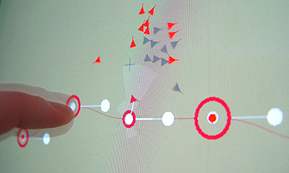Content Description
loopArena is a generative music interface for live - performance of loopbased computer music.
on a touchscreen, the user is able to control eight MIDI-Instruments such as sythesizers or samplers (soft- and hardware) and a drumcomputer in a playful way.
Every element of the interface is an agent, which means it is enabled to act autonomously. The agents are programmed to generatively alter the music loop, help the user create harmonic melodies and at the same time to inspire the user and animate him to interact with the agents.
No typography, rasters and tools are used, interaction is limited to dragging objects with the fingertips.
Any moving element has a function, the "toolbar" is constantly changing.
Musical alteration of the Loop is visible to the user.
the stage
The stage expands over the whole screen, the agents move in the upper "loop-zone". Invisible to the user this section is divided by a vertical raster of notes of a prdefined scale and a horizontal raster of 16 1/16 beats, which are sequentially triggered and form a whole Bar.
The lower "control-zone" contains some static controllers.
agents
There are two main types of agents:
BeatAgents and NoteAgents.
NoteAgents play MIDI notes depending on their horizontal and vertical position in the loop-zones' raster.
BeatAgents play the drums of a connected drumcomputer.
Note- and BeatAgents can be dragged and activated and deactivated by touching them. NoteAgents have an additional handle which controls the duration of the played Note.
behaviour
The NoteAgents have the most complex behaviour: they constantly count beats, after a random number of beats they move in a random direction for one beat, then check the other agents' positions and move to a point where they would play a note in a harmonic interval to the previously played note.
After eight bars, all agents return back to the position where the user dropped them on the stage, playing the"motive" of the melody. Due to this, the musical result is not random, but plays around the users' input.
The BeatAgents work in a similar way, the difference is that their random movement is restricted to the x-axis. and controlled by rhythmic rules. This is because their vertical position does not change the pitch of the drum but the played drum itself.
For them, the loop zone is divided vertically into a raster of 10 possible drums.
helper-agents
the helper agents are what normally would be switches, faders or any other tool: they have the ability to influence the melody by changing velocity, position and status of any NoteAgent or by changing the sound itself.
The Rule: anything that moves can be dragged and used.
The TargetAgent creates a trace of spots that attract the active and focused NoteAgents. By using targets, the user can influence the melody temporarily. When a large amount of targets is near a NoteAgent, it resets its motive position to this new spot.
With the SwitchAgents, the user can switch a group of NoteAgents on and off. The user drags one SwitchAgent out of the swarm over a group of NoteAgents, if the first one is active, the SwitchAgent will deactivate all active NoteAgents and vice versa.
The VelocityAgents (black and white) create a cloud which increases or decreases the NoteAgents' NoteVelocity (Velocity = how "hard" a note is played).
The ControllerAgents are moving in a swarm until they are irritated
by touching. Then they become aggressive and start to change sound parameters of one nearby NoteAgent. After that they return to the Swarm.
controls
Additional controls are the instrument controllers on the lower edge of the screen. By dragging them the user can create new NoteAgents or BeatAgents and mute the beat or a whole instrument group.
By dragging Note- and BeatAgents to the dark-red area, they are deleted.
The coloured triangle on the right side of the screen is used to change the vertical position (pitch) of the focused instrument group.


